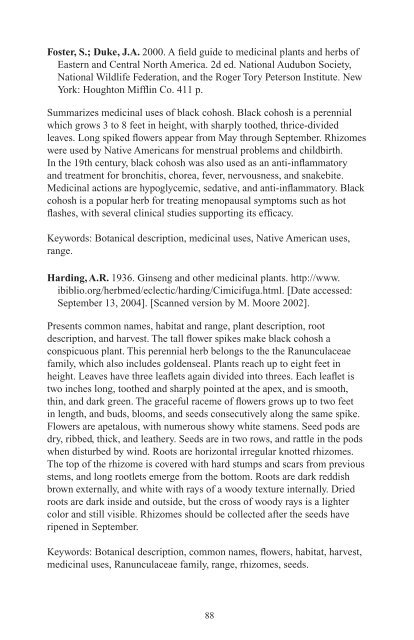Black Cohosh - Non-Timber Forest Products
Black Cohosh - Non-Timber Forest Products
Black Cohosh - Non-Timber Forest Products
Create successful ePaper yourself
Turn your PDF publications into a flip-book with our unique Google optimized e-Paper software.
Foster, S.; Duke, J.A. 2000. A field guide to medicinal plants and herbs of<br />
Eastern and Central North America. 2d ed. National Audubon Society,<br />
National Wildlife Federation, and the Roger Tory Peterson Institute. New<br />
York: Houghton Mifflin Co. 411 p.<br />
Summarizes medicinal uses of black cohosh. <strong>Black</strong> cohosh is a perennial<br />
which grows 3 to 8 feet in height, with sharply toothed, thrice-divided<br />
leaves. Long spiked flowers appear from May through September. Rhizomes<br />
were used by Native Americans for menstrual problems and childbirth.<br />
In the 19th century, black cohosh was also used as an anti-inflammatory<br />
and treatment for bronchitis, chorea, fever, nervousness, and snakebite.<br />
Medicinal actions are hypoglycemic, sedative, and anti-inflammatory. <strong>Black</strong><br />
cohosh is a popular herb for treating menopausal symptoms such as hot<br />
flashes, with several clinical studies supporting its efficacy.<br />
Keywords: Botanical description, medicinal uses, Native American uses,<br />
range.<br />
Harding, A.R. 1936. Ginseng and other medicinal plants. http://www.<br />
ibiblio.org/herbmed/eclectic/harding/Cimicifuga.html. [Date accessed:<br />
September 13, 2004]. [Scanned version by M. Moore 2002].<br />
Presents common names, habitat and range, plant description, root<br />
description, and harvest. The tall flower spikes make black cohosh a<br />
conspicuous plant. This perennial herb belongs to the the Ranunculaceae<br />
family, which also includes goldenseal. Plants reach up to eight feet in<br />
height. Leaves have three leaflets again divided into threes. Each leaflet is<br />
two inches long, toothed and sharply pointed at the apex, and is smooth,<br />
thin, and dark green. The graceful raceme of flowers grows up to two feet<br />
in length, and buds, blooms, and seeds consecutively along the same spike.<br />
Flowers are apetalous, with numerous showy white stamens. Seed pods are<br />
dry, ribbed, thick, and leathery. Seeds are in two rows, and rattle in the pods<br />
when disturbed by wind. Roots are horizontal irregular knotted rhizomes.<br />
The top of the rhizome is covered with hard stumps and scars from previous<br />
stems, and long rootlets emerge from the bottom. Roots are dark reddish<br />
brown externally, and white with rays of a woody texture internally. Dried<br />
roots are dark inside and outside, but the cross of woody rays is a lighter<br />
color and still visible. Rhizomes should be collected after the seeds have<br />
ripened in September.<br />
Keywords: Botanical description, common names, flowers, habitat, harvest,<br />
medicinal uses, Ranunculaceae family, range, rhizomes, seeds.<br />
88


